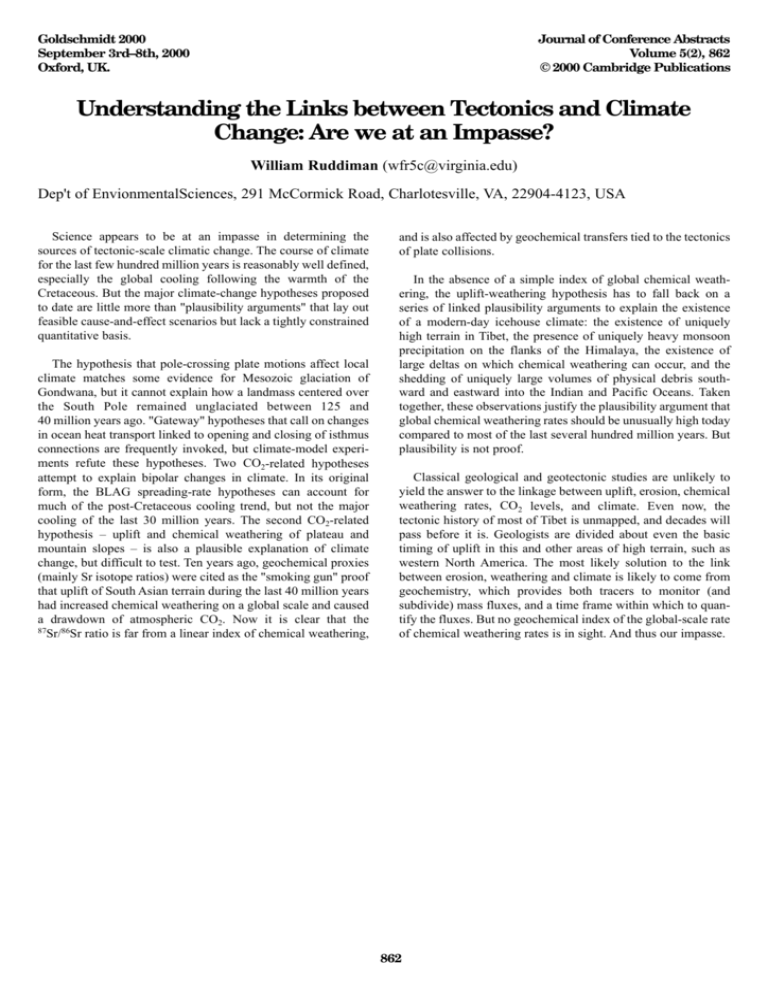862 - Cambridge Publications
advertisement

Goldschmidt 2000 September 3rd–8th, 2000 Oxford, UK. Journal of Conference Abstracts Volume 5(2), 862 © 2000 Cambridge Publications Understanding the Links between Tectonics and Climate Change: Are we at an Impasse? William Ruddiman (wfr5c@virginia.edu) Gold2000.H.1156 Dep't of EnvionmentalSciences, 291 McCormick Road, Charlotesville, VA, 22904-4123, USA Science appears to be at an impasse in determining the sources of tectonic-scale climatic change. The course of climate for the last few hundred million years is reasonably well defined, especially the global cooling following the warmth of the Cretaceous. But the major climate-change hypotheses proposed to date are little more than "plausibility arguments" that lay out feasible cause-and-effect scenarios but lack a tightly constrained quantitative basis. The hypothesis that pole-crossing plate motions affect local climate matches some evidence for Mesozoic glaciation of Gondwana, but it cannot explain how a landmass centered over the South Pole remained unglaciated between 125 and 40 million years ago. "Gateway" hypotheses that call on changes in ocean heat transport linked to opening and closing of isthmus connections are frequently invoked, but climate-model experiments refute these hypotheses. Two CO2-related hypotheses attempt to explain bipolar changes in climate. In its original form, the BLAG spreading-rate hypotheses can account for much of the post-Cretaceous cooling trend, but not the major cooling of the last 30 million years. The second CO2-related hypothesis – uplift and chemical weathering of plateau and mountain slopes – is also a plausible explanation of climate change, but difficult to test. Ten years ago, geochemical proxies (mainly Sr isotope ratios) were cited as the "smoking gun" proof that uplift of South Asian terrain during the last 40 million years had increased chemical weathering on a global scale and caused a drawdown of atmospheric CO2. Now it is clear that the 87Sr/86Sr ratio is far from a linear index of chemical weathering, and is also affected by geochemical transfers tied to the tectonics of plate collisions. In the absence of a simple index of global chemical weathering, the uplift-weathering hypothesis has to fall back on a series of linked plausibility arguments to explain the existence of a modern-day icehouse climate: the existence of uniquely high terrain in Tibet, the presence of uniquely heavy monsoon precipitation on the flanks of the Himalaya, the existence of large deltas on which chemical weathering can occur, and the shedding of uniquely large volumes of physical debris southward and eastward into the Indian and Pacific Oceans. Taken together, these observations justify the plausibility argument that global chemical weathering rates should be unusually high today compared to most of the last several hundred million years. But plausibility is not proof. Classical geological and geotectonic studies are unlikely to yield the answer to the linkage between uplift, erosion, chemical weathering rates, CO2 levels, and climate. Even now, the tectonic history of most of Tibet is unmapped, and decades will pass before it is. Geologists are divided about even the basic timing of uplift in this and other areas of high terrain, such as western North America. The most likely solution to the link between erosion, weathering and climate is likely to come from geochemistry, which provides both tracers to monitor (and subdivide) mass fluxes, and a time frame within which to quantify the fluxes. But no geochemical index of the global-scale rate of chemical weathering rates is in sight. And thus our impasse. 862





